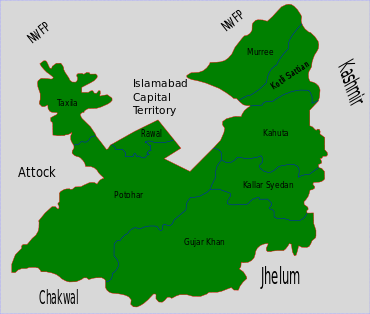Kahuta Tehsil
| Kahuta Tehsil | |
|---|---|
| Tehsil | |
 | |
| Country | Pakistan |
| Region | Punjab |
| District | Rawalpindi District |
| Capital | Kahuta |
| Towns | 1 |
| Union councils | 13 |
| Time zone | PST (UTC+5) |
| • Summer (DST) | PDT (UTC+6) |
Kahuta Tehsil (Urdu: تحصیل کہوٹہ) is one of the eight tehsils (subdivisions) of Rawalpindi District in the Punjab province of Pakistan. The neighbouring tehsils of Kotli Sattian & Kallar Sayedan used to be part of Kahuta, but was later created as saprat tehsils.The name Kahuta was derived from "Koh" a local medicinal tree (Look the leaves as Oliven) and "Boota". Perhaps "Koh Boota" was shortened to Kohuta/Kahuta over the passage of time.
History
In 997 CE, Sultan Mahmud Ghaznavi, took over the Ghaznavid dynasty empire established by his father, Sultan Sebuktegin, In 1005 he conquered the Shahis in Kabul in 1005, and followed it by the conquests of Punjab region. The Delhi Sultanate and later Mughal Empire ruled the region. The Punjab region became predominantly Muslim due to missionary Sufi saints whose dargahs dot the landscape of Punjab region.
After the decline of the Mughal Empire, the Sikh Empire invaded and occupied Rawalpindi District. The Muslims faced restrictions during the Sikh rule. During the period of British rule, Kahuta Tehsil increased in population and importance.
In the 18th century, Kahuta along with much of the South Asia became part of British India, the undivided tehsil (which includes what is now Kallar Syedan Tehsil) is described in the "Imperial Gazetteer of India" as follows:
| “ | Kahuta-Eastern tahsil of Rawalpindi District, Punjab, lying in the Lower Himalayas, between 33° 18′ and 33° 48′ N. and 73° 15′ and 73° 39′ E., with an area of 206 square miles. Its eastern border rests upon the Jhelum River. The whole of the tahsil except the south-west corner lies in the hills, which in the north reach an elevation of over 6,000 feet. The population in 1911 was 94,719, compared with 91,371 in 1891. It contains 231 villages, of which Kahuta is the headquarters. The land revenue and cesses amounted in 1913-4 to 1.2 lakhs.[1] | ” |
The predominantly Muslim population supported Muslim League and Pakistan Movement. After the independence of Pakistan in 1947, the minority Hindus and Sikhs migrated to India while the Muslims refugees from India settled down in the Rawalpindi District. It is worth mentioning that ancestors of many of the Mulim League leaders in the tehsils of Rawalpindi district supported Unionist Party which was against the division of India but after partition seized the opportunity and started supporting the divide and advocating Two Nation Theory and grabbing the top leadership positions in politics of Pakistan by joining Muslim League. These people were staunch supporters of the British Raj and Congress as well. Birth of Pakistan opened an avenue for them to seize political power and change the face.Subedar Kala Khan of Murree was the Muslim League's leader who defeated Unionists in Rawalpindi district at that time.
Secondly, people from Pothwar were the ones who ignited the fire of Hindu/Muslim/Sikh genocide at the time of partition by attacking the family of Master Tara Singh at Mandra Railway Station on their way to India. Stories of widespread riots, looting and burning of groups of people hiding inside the buildings owned by Hindus and Sikhs in the towns like Nara Motor, Kallar Seyedin, Bewal, Choa Khalsa, Kahuta, Dera Khalsa, Mandra, Gujar Khan are still around. You can read stories of atrocities and genocide in "The 1947 Partition Archive" on Facebook.There are some stories on YouTube as well.
In 2009 a weekly newspaper from kahuta has been published named Kahuta Times. whose founder was Raja shahzad ahmad.
Administration
The tehsil is administratively divided into 13 Union Councils, two of which form the city of Kahuta; these are:[2]
| UC34 | Name of mawara |
|---|---|
| Uc-30 | Narh |
| Uc-31 | Punjar |
| Uc-32 | Khadiot |
| Uc-33 | Doberan Khurd |
| Uc-34 | Mowara |
| Uc-35 | Beor |
| Uc-36 | Matore |
| Uc-37 | Nara |
| Uc-38 | Dakhali |
| Uc-39 | Hothla |
| Uc-47 | Kahuta I |
| Uc-48 | Kahuta II |
| Uc-116 | Khalol |
| Uc-117 | Lehri |
Demography
According to the 1998 census of Pakistan, Kahuta has a total population of 153,000.[2] Many clans are living in Kahuta like Khattars, Qazis, Janjuas, Jandrans,Dhund Abbasis, Jasgams, Siddiquis, Sattis, Awans, Maliks, Arains, Gakkhars, Narma, Mughals, Chauhans and many more castes are also present now because city expands day by day but they are smaller in numbers.
